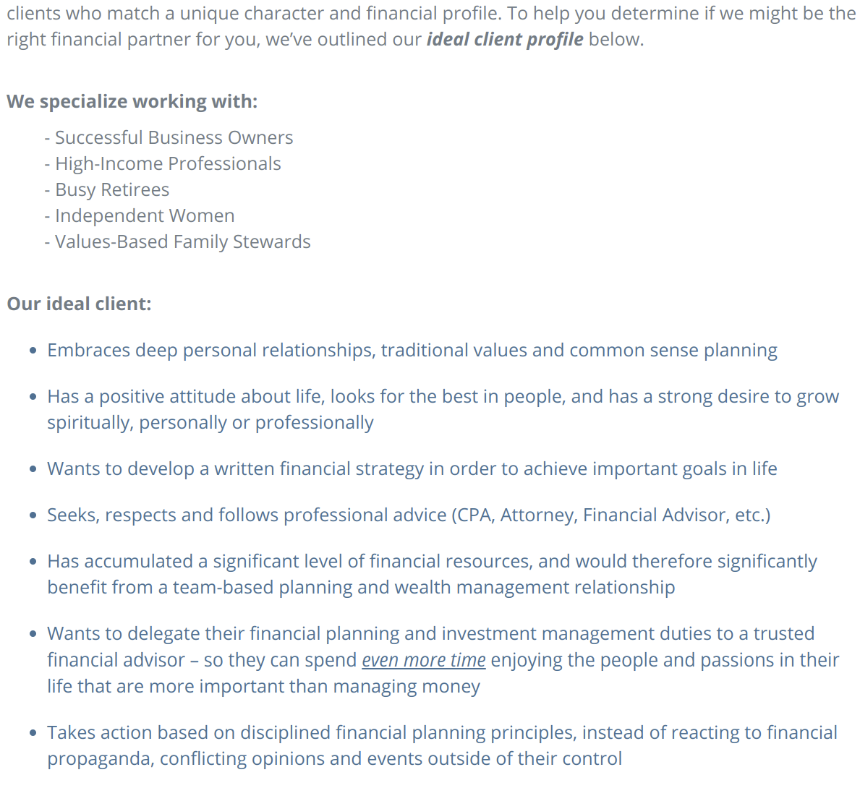
Note: This is a behind the scenes, follow-along guide to creating a detailed buyer persona for an individual client. It’s perfect for B2C companies or service businesses that sell directly to individual clients, such as coaches, consultants, or financial advisors.
If your entity sells to other organizations, you’ll first need to define your Ideal Customer Profile (ICP). Read our complete guide to creating a B2B ICP here.
Ready to build a powerful buyer persona? This is a crucial step for any service provider, whether you’re creating a B2C or a B2B buyer persona.
This integral marketing intelligence document will empower you to uncover exactly what your ideal client wants vs. what turns them off, and how to position yourself right where they’re looking.
This integral marketing intelligence document will empower you to uncover exactly what your ideal client wants, what turns them off, and how to position yourself right where they’re looking.
You can also outsource this time-intensive process, and hire us to build your personas.
To ensure that we start out on the same page, let’s first define buyer personas.
What is a buyer persona?
A buyer persona—sometimes called a client profile or customer profile—is a detailed, semi-fictional prototype of your ideal individual client. It’s the document you compile and then use to identify, understand, and attract the specific human you’re targeting.
The goal is to curate a buyer persona “story“ that brings their challenges and goals to life, allowing you to market to them with true empathy and precision.
This process works when profiling both individual consumers and specific decision-makers within a larger company. (For more on profiling the company itself, see our guide to ICPs.)
To ensure we have a well-rounded view of our ideal buyer, we’ll build a persona covering:
- demographics (your client’s “stats,” like gender, age, and profession),
- psychographics (their lifestyle, values, and how they make decisions), and
- geographics (where they are and how that influences your outreach).
By the end, you’ll be set to create a buyer persona for your desk, your wall, or to give your team as a quick reference.
Let’s start!
This follow-along guide shows the types of strategic decisions you’ll encounter when creating your personas.
To show you how these concepts work in the real world, this guide will walk you through the persona-building process from the perspective of a fictional service provider.
Meet Langston.
He’s a Certified Divorce Financial Analyst (CDFA) who wants to build his practice by serving a specific niche: Newly divorcing university professors.
He doesn’t have any clients who fit this exact profile yet, so he’s starting from scratch.
As we go through each step of building a buyer persona, we will follow Langston’s research, analysis, and decision-making process. You’ll see not just what to do, but how to think strategically when the data presents conflicts or requires a judgment call.
Most businesses believe that focusing on a narrow niche means a smaller pool of leads. The opposite is true. The more specific your message, the more powerfully it resonates with the right people.
When a potential client feels like your marketing was written specifically for them, they instantly assume you understand their needs better than any generic competitor—before you even say a word. This allows you to build trust and authority much more efficiently than if you were trying to address the vague needs of 10 different client types at once.
Consider the 2% rule.
On average, only about 2% of people who see your initial marketing message are ready to buy immediately:
If 100 people see your message, maybe 20 visit your site, 5 sign up for your email list, and only 2 become clients.
This guide is about finding those two people.
By focusing your resources on the small segment of the market that is actively seeking a solution, your work becomes easier and more cost-effective. You stop watering down your message to cater to the 98% who weren’t going to buy from you anyway.
When you have this level of clarity, you can even state exactly who you serve directly on your website, which acts as a powerful filter and magnet for your ideal clients.
Example from 215 Advisors’ “Who We Serve” Page:
This approach pre-qualifies prospects and demonstrates confidence and expertise.
So let’s get to work.
To build an effective, data-driven persona, you should have a few things in place.
- A specialized service. Your offering must solve a specific, important problem for a particular type of person.
- At least three paying clients. The best personas are based on real-world data from people who have already paid you for your specialized service.
- Access to your ideal clients (recommended). The fastest way to get accurate data is to ask your best clients directly. A brief interview in exchange for a small reward (like a 30-minute strategy session or a gift card) can provide invaluable insights.
No ideal clients yet? Start here.
If you’re launching a new service and don’t have paying clients, you’ll simply build a working draft of your persona. Start by defining the client you want to attract based on three core characteristics:
- Profession or age
- Minimum income level
- Ethnicity or cultural background
This working draft is your starting point. You must commit to revising and refining it as you begin working with actual clients and gathering real-world data.
A final tip before starting:
You’ll be searching data available to the public (vs. what’s available to marketing professionals).
If you’re ever unable to find a specific or relevant data, you can assume that trait isn’t a major differentiator for your persona. In those cases, either omit it for now or fill in data that makes the most sense.
Demographics are the objective, factual data points about your ideal client. The goal here is not to guess, but to build your persona based on data from either your best existing clients, or from targeted research.
It’s important to note that we advise your demographic research to be about understanding vs. targeting. This way, you may avoid the legal risk of targeting by identity, or “protected characteristics.”
Tip: Remember also that we’re following the persona building process for our fictitious financial firm owner, Langston, a Certified Divorce Financial Analyst. And he’s thinking of serving newly divorcing professors.

Understanding the cultural context of your ideal client is important for building trust and rapport. It allows you to more deeply understand their core needs, pain points, to more effectively communicate in a relevant, resonant way.
Start by looking at your current ideal clients. Is there a common cultural background?
Your goal here is not choosing a culture to target; it is simply not guessing. This helps you better understand the most likely audience members within this industry, to prepare your marketing and messaging.
Putting it Into Practice
Langston, our financial advisor, checks the data.
- Initial Research: A search for “primary demographic makeup of university professors” reveals the current breakdown:
-
- White: 72% (35% female, 37% male)
- Asian: 13% (6% female, 7% male)
- Black: 7% (4% female, 3% male)
- Hispanic: 6% (3% female, 3% male)
- Strategic Analysis: Langston now sees that many of his potential clients may be white women. He also observes that a significant chunk of the market—about one-quarter—will be multicultural.
- Holding the Data: Langston holds onto this info, waiting to see how it intersects with other data points as he continues his research.

Age often correlates with life stage, income, and specific needs. Again, age (40+) being a protected class—our goal here is not targeting or exclusion, but to better understand the life stage and potential challenges of the market you serve.
Putting it Into Practice
Here, Langston’s research uncovers a significant conflict between two key data points.
- Initial Research: He finds that the highest concentration (36%+) of divorces occur between the ages of 20 to 29. But the average age of a tenured professor is 55, with few in the field under the age of 40.
- Strategic Analysis: Langston could target another profession more common to 20-somethings, to move toward the higher divorce rate. Or, he could stick with his target profession of professors, knowing that their average 40+ age group has a much lower statistical divorce rate (only 5 to 9%).
- Holding the Data: He decides to stay the course. The foundation of his business thus far—and all his marketing material!—has been built around serving professors. He accepts the trade-off, solidifying his buyer persona’s expected age as 40 and up, consistent with the professional demographic he’s equipped to serve.

While your service may be gender-neutral like many, market data might reveal that one gender is more likely to seek your specific solution. As gender is a protected characteristic, the goal here is not to exclude or target in this way, but to understand the nuances of your market to communicate with them more effectively.
Putting it Into Practice
Here, Langston’s research uncovers a significant conflict between two key data points.
- Initial Research: Langston’s research on divorce rates for individuals over 40 shows that women are slightly more likely to get divorced than men. He also refers back to his faculty data, which shows that women make up a significant portion of his target profession (41% of all professors).
- Strategic Analysis: Combining the divorce rate data with the faculty demographics gives him a clearer picture. The data suggests that his most likely client, a divorcing professor over 40, is statistically more likely to be a woman.
- Holding the Data: Based on the data, Langston solidifies his focus. His buyer persona is more likely female. This allows him to tailor his messaging to address potential concerns and communication styles that may be more common among women navigating the divorce process.

Langston obviously knows this one, because he’s working with people going through a divorce. (It’s typical that we’ll know at least one piece of demographic data for certain.)
But if he didn’t know?
He’d try to find this data as it relates to other data he knows. For instance, if he were targeting “race car drivers” or “parents in Tampa, Florida,” he’d search “what percentage of race car drivers are married.” Or maybe “average demographics of Tampa parents.”
Remember that if unable to find anything that stands out in the data available, he can assume this stat isn’t significant. Then he’d either leave it out of his buyer persona, or simply choose one side or another.
Putting it Into Practice
Here, Langston’s research uncovers a significant conflict between two key data points.
- Initial Research: N/A. Langston is a Certified Divorce Financial Analyst (CDFA). His buyer persona will likely be divorced or separated.

Major life experiences—both positive and negative—shape a person’s values, fears, and priorities. This insight is critical because it helps you understand their underlying needs, which is the foundation of connected, effective, culturally-sensitive marketing.
Try hard to avoid making assumptions based on demographics. Unconscious bias is a real thing. Instead, look for patterns in your audience’s journey. What stereotypes exist about them? Make it a point to set those aside and be objective.
- What challenges have they overcome?
- What triumphs have defined them?
These experiences directly influence what they need from a service provider.
Putting it Into Practice
Langston already knows his persona is navigating a major life event: a divorce. That’s the immediate pain point. But to truly connect, he needs to understand the experiences that shaped her long before the divorce proceedings began.
He layers his research, looking at both her professional journey and the broader context of her demographic.
- Initial Research:
- Academic: He confirms that becoming a tenured professor is a long, tough road. It usually means taking on significant student debt (over $100,000 for a Ph.D. on average) and working for years in low-paying, insecure jobs before landing a stable position (AAUP, 2024).
- Social: Since most professors are both women and white and he is neither, he researches the common experiences of Caucasian women. He finds data pointing to an increase in “deaths of despair,” plus high levels of economic anxiety, even for the middle class (Brookings Inst., 2024). He also notes the complicated and divided views on racial advantage—a dynamic he needs to be aware of (Pew, 2019).
- Strategic Analysis: Langston now has a fuller, more complex picture. His ideal client has two sides to her. On one hand, she’s a disciplined, logical, and resilient high-achiever who has cleared immense professional hurdles. On the other, she may be dealing with underlying personal and financial anxieties that are common within her demographic. He is surprised and intrigued by this data, and is glad he did the research and avoided common assumptions.
- Holding the Data: Understanding both sides of her is crucial. Her “academic” side needs a financial plan that is data-driven, logical, and clearly explained. Her “personal” side needs reassurance, empathy, and a deep sense of security. She isn’t just protecting assets; she’s protecting a hard-won stability that feels more fragile than it might appear from the outside. This insight allows Langston to prepare a communication style that is both intellectually sharp and genuinely supportive.

Of course, in this case, we know Langston started out by targeting professors.
But if he didn’t know?
Your persona’s profession often serves as a key anchor point. (That’s actually why we started with it. It’s because we can often find a lot of data that helps us test our assumptions, or bring other demographic details into focus.)
Putting it Into Practice
This is exactly how Langston uses this step to finalize his decision. He already knows from his earlier research that Caucasian women make up the largest demographic segment of university professors.
This single data point, tied directly to his chosen profession, solidifies his strategy. He can now confidently move forward with a primary persona built around a white female professor, age 40 and up, knowing the market size is substantial enough to support his focus.

This is often a simple data point, but it provides important context about your persona.
Putting it Into Practice
Because Langston is focusing on university professors, this piece of the puzzle is easy to place.
- Initial Research: He does a quick search for “typical education level of university professors” to confirm his assumption. He finds that while requirements can vary, a Ph.D. or another terminal degree* is the standard qualification, particularly at four-year institutions (Bureau of Labor Statistics, 2024).
- Strategic Analysis: This is a simple, clarifying fact. It tells him his ideal client is an expert in her field who likely values logic and evidence.
- Holding the Data: Langston confidently adds “Doctorate or other terminal degree” to his persona profile.
*highest degree level in a particular field

Understanding your persona’s family structure helps clarify their financial priorities, time constraints, and personal responsibilities. This information adds another important layer to their profile.
Putting it Into Practice
Langston does a simple search to understand his persona’s likely family situation.
- Initial Research: He searches for “what percentage of university professors have children.” The data shows that female professors are significantly less likely to be married with children compared to their male colleagues. Given his persona’s age (40+), any children she does have are likely to be adults who no longer live at home (American Council on Education, 2023).
- Strategic Analysis: This is a key insight. It suggests his ideal client’s financial life probably isn’t centered around immediate child-rearing costs like tuition or daily expenses. Her focus is more likely on securing her own long-term financial independence, planning for retirement, and managing her assets for herself.
- Holding the Data: Langston adds “Likely has no young children living at home” to his profile. This helps him understand her potential financial concerns.

Location matters. It influences income, cost of living, culture, and lifestyle. Pinpointing where your ideal client likely lives helps you understand their world and informs how you might reach them, even if you work virtually.
People in different areas of the U.S. have very different personalities, pet peeves, ways of interacting with others… and incomes. And those are only a few of many crucial distinctions.
Putting it Into Practice
Langston wants to find clients outside of his home state. He uses his persona’s profession and income requirements to guide his search.
- Initial Research: He starts by searching for “which states have the most university professors.” The top results consistently include California, New York, Texas, and Florida (World Atlas, 2024). He then researches the cost of living in these states to see how it aligns with his persona’s likely income. California and New York have a very high cost of living, which could add financial pressure, while Texas and Florida are comparatively more affordable (MERIC, 2024).
- Strategic Analysis: Langston cross-references this with his persona’s profession and life experiences. He knows tenured professors earn a solid income, but a high cost of living can erode that financial security, especially during a divorce. A location with a lower cost of living, but still a high concentration of universities, seems like the sweet spot. Florida, with its large state university system and no state income tax, emerges as a strong candidate.
- Holding the Data: Langston decides to target professors in Florida, in addition to his own home state. (Pro Tip #1: He can get even more specific later by researching FL cities with major universities to further refine his marketing.)
Pro Tip #2: If you’re unsure which cities, consider what you DO know (or want to target), like occupation, income, and ethnicity. Then, search for the area of the U.S. that has the most of that combination of things (occupation, income, ethnicity).
For example, Langston can search “which states have the most university professors.” When he does, he finds that the top four states housing full professors are:
- California
- Minnesota
- Connecticut
- Wisconsin
Since the minimum income he wants his Perfect Client to have is $75K (established at the start), he waits to choose the top three until he does a little research on how location affects income.
Important: Also consider cost of living when deciding where your Perfect Client lives, to make sure the minimum income you chose puts them in the income class you envisioned.
Langston searches for “cost of living U.S. comparison chart by state” and finds (something called the “Cost of Living Index by State.” It uses a scale of 1 to 200, where 1 would be near free, and 200 would be outlandishly expensive.
- California: 151.7 (value of a dollar: $0.87)
- Minnesota: 101.6 (value of a dollar: $1.08)
- Connecticut: 127.7 (value of a dollar: $1.03)
- Wisconsin: 97.3 (value of a dollar: $1.08)
Looking at these numbers, he decides to try Wisconsin.
Since he doesn’t know anything about it and has never been, he researches what it’s like. Good thing that he does, because he finds that it’s considered the most segregated state in America and one of the worst places to live for people of color.
Yikes.
This new data makes him believe it would be very difficult to get clients from this area. Even still, he makes the decision to try targeting potential clients there as a test. He can easily switch the location of target later if he doesn’t get a good response.

Knowing your ideal client’s income is key. It tells you if they can afford you and helps you understand their financial situation. When setting this, it’s practical to target an income level that makes sense for your prices.
Putting it Into Practice
Langston wants to make sure his ideal client can comfortably afford his services. He uses his location research to figure out a realistic income level.
- Initial Research: Langston has decided to target professors in Florida. To narrow it down, he searches for “florida cities with major universities” and identifies Gainesville (UF) and Tallahassee (FSU). He then searches for “average full professor salary gainesville fl” and “average full professor salary tallahassee fl.”
- Strategic Analysis: He finds that average salaries in these cities are well over six figures (Glassdoor, 2025). For example, a full professor at the University of Florida can earn an average of $160,000. This is well above the $75,000 minimum he set initially, so he knows his target client can afford his help.
- Holding the Data: Langston sets his ideal client’s income at “$150,000+.” He also lists his own city and state as a target location, since it’s easiest to start with local prospects who fit this same profile.
Pro Tip: If you’re not sure yet of your ideal client’s location at this stage, you can start with a salary based on the U.S. average for the chosen profession. (You could also search for something like “U.S. cities where professors earn the most” to help decide.)
To get an idea of average yearly income for your persona in a particular field, and in a particular location, just search for “[job title] [salary] [city] [state].”
Langston wants to target a region that has the most professors, but he also wants them to make at least $75,000 per year and have a reasonably low cost of living.
Since we only have states so far, our advisor can first search “which wisconsin cities have the most universities.” He finds that the most and largest institutions are in Milwaukee and Madison.
So now, he can search “average full professor salary milwaukee, wi,” and “average full professor salary madison, wi.”
From Glassdoor, he finds:
- average full professor salary milwaukee, wi ($117,646)
- average full professor salary madison, wi ($154,127)
So, despite the troubling location info from the last research step, he tentatively decides to target professors in Madison, WI. But he also lists the city and state where his own firm is located, because it will be easy to target his persona there, too.
Once you’ve gathered key demographics (the “what”), it’s time to consult social media and more for deeper psychographics (“the why”). Here’s where it gets fun.
Here, you’ll begin to understand your persona’s lifestyle, values, personality, and decision-making process. This is how you learn to speak their language.
The goal is to find and analyze public content related to their needs and problems. You’re looking for how they describe their challenges, what they value, and what solutions they seek.
If you have existing ideal clients.
The best place to start is with your three most perfect existing clients. You can analyze public-facing content they’ve created (like LinkedIn articles or personal blogs) or, with their permission, interview them directly to understand their perspective.
If you don’t have ideal clients yet.
Your starting point is different. Search for public content using the most uniquely defining characteristics of your ideal client.
For example, Langston would search for content using terms like: “divorced university professor blog” or “articles by professors on divorce.”
While searching social media directly for people can be a long shot, using a standard Google search for content often brings up excellent fodder. Langston’s search for “divorced university professor” brought up several.
One doesn’t fit our persona, because it’s about a male professor. But one is a perfect fit: an article about a 44-year-old Philosophy and Ethics professor. We’ll call her “Betty Dollywop.”
What to look for when analyzing content.
Spend at least 15 minutes browsing each article or public post you find. As you read, look for clues that reveal the author’s perspective. Pay special attention to their language and wording, but also try to read between the lines.
You’re looking for things like:
- The language they use (formal, casual, witty, direct?)
- Important personality traits that come through (analytical, empathetic, cynical, optimistic?)
- Their expectations and standards (what do they value in their interactions?)
- Their stated passions and interests.
- Their biggest pet peeves.
- Their allegiances (to a cause, a community, an institution?)
- Their overall outlook on life.
Putting it Into Practice
For the article written by “Betty,” our Philosophy and Ethics professor, Langston takes these notes:
- Language: Not a stickler for grammar (uses lowercase sentence starts), has a wry wit.
- Personality: Comes across as extroverted, ethical, and social.
- Expectations: Values high ethics, fairness, and open-mindedness.
- Passions: Philosophy and social justice are clearly important to her.
- Pet Peeves: Seems averse to being boxed in or making small talk.
- Overall Outlook: Appears amused, free-spirited, and positive.
Continuing down the search results, Langston finds another relevant piece of content: a blog post by a 59-year-old Professor of Law. We’ll call her “Tamela.”
For Tamela’s post, he notes:
- Language: Defined, professional, and intelligent.
- Personality: Comes across as an ethical realist.
- Expectations: Values high ethics, fairness, and justice.
- Passions: Human rights, ending racism and domestic violence, and community involvement.
- Allegiances: To her faith, family, community, and sorority.
- Overall Outlook: Realistic, but committed to creating positive change.
By analyzing a few pieces of content like this, you can begin to identify the important patterns and overlapping values of your ideal client. These serve as guideposts to help you understand what they need and how to connect with them authentically.

Understanding what your persona does for fun reveals their underlying values and priorities, which helps you connect with them on a more human level.
When you can proactively intuit and serve your clients’ deepest needs—especially those they haven’t expressly shared—you appear more understanding. This increases their trust in you and their loyalty to your organization.
Putting it Into Practice
Langston searches for “what professors do in their spare time.”
- Initial Research: Since he’s unable to find any central databases of hobby data, he finds common themes through forums and articles in the search results. Many are avid readers and writers, even outside of their professional work. They often decompress with small groups of trusted colleagues, and many mention the companionship of pets to offset the solitary nature of their research.
- Strategic Analysis: Langston reads between the lines. These common hobbies aren’t random; they point to deeper needs. A love of reading suggests a curious mind. A preference for small gatherings suggests a need for comfort and trusted relationships. A beloved pet points to a desire for security and loyalty. The common thread here is a need for comfort, stability, and security.
- Holding the Data: Langston adds these researched interests to his profile. He recognizes that the underlying need for security is precisely why someone in her position would seek out a Certified Divorce Financial Analyst.
Langston is happy to realize that his theory about how hobbies are important rings true with what he already knows about this market. His client is concerned about maintaining a level of comfort and financial security after their divorce, and they’re seeking to protect their assets. This is exactly why his Perfect Client would choose a CDFA.
It validates that his service directly addresses a core emotional driver, not just a practical problem. This new data helps in his business, too. Because now, he might recommend safer investments than usual, like Certificates of Deposit (CDs) and money market accounts, to see how clients respond.
Pro Tip: If passions or hobbies don’t stand out as important or related to your overall persona at this stage, no worries. You’ll grow to recognize the patterns as you develop a stronger picture of your ideal client over time.
What’s important to them when making (buying) decisions?
Now it’s time to connect the dots. You’ve analyzed your persona’s language, values, and passions. This final psychographic step is about translating all those clues into a shortlist of what actually drives their buying decisions.
What do they need to see, hear, or feel from you before they’ll trust you with their business?
Putting it Into Practice
Langston reviews his notes on the public content from “Betty” and “Tamela.” He’s looking for any patterns that may connect their behavior.
- Strategic Analysis: He synthesizes the data he’s already gathered:
- Both “Betty” and “Tamela” place an extremely high value on ethics, fairness, and justice. In a financial relationship, this means they will need absolute transparency. They will be highly allergic to confusing jargon, hidden fees, or anything that feels like a sales pitch.
- Their professional backgrounds mean they value logic, evidence, and expertise. They won’t be swayed by emotional appeals alone. They will need to see a clear, logical process and be confident that Langston is a master of his craft.
- Their focus on community and advocacy means they are looking for a true partner, not just a service provider. They need to feel that their advisor is unequivocally on their side, advocating for their best interests.
- Holding the Data: Langston now has a clear list of his ideal client’s core buying drivers. She makes decisions based on:
- Trust through Transparency: She needs to see all the cards on the table.
- Confidence through a Clear Process: She needs to understand the “why” behind the strategy.
- Respect for Proven Expertise: She needs to know she’s hiring a top-tier professional.
- A Feeling of True Partnership: She needs an advocate in her corner.
With this list, Langston now understands exactly what he needs to demonstrate in his marketing and his initial consultations to win his ideal client’s business.
Define your “negative buyer persona” (or exclusionary persona).
Just as important as knowing who you want to attract is knowing who you want to avoid. A negative buyer persona (A.K.A. “exclusionary persona”) is a concrete profile of the client who is a terrible fit for your business.
Defining this person saves you time, money, and headaches.
Instead of focusing on abstract personality traits, let’s identify tangible red flags. What characteristics does your worst-nightmare client have?
Start with these three categories:
- Budgetary Red Flags. This client consistently questions your prices, tries to haggle for discounts outside of any standard offers, has unrealistic expectations for their budget, or is chronically late with payments.
- Behavioral Red Flags. This client disrespects your time and boundaries, is chronically indecisive, dismisses your professional advice, or constantly creates “emergencies” that lead to scope creep. They drain your energy and make projects a struggle.
- Logistical Red Flags. This client might be in an industry you don’t serve, be a company of the wrong size, or have technical needs that fall outside your core expertise. They may seem like a good client, but they pull you away from your zone of genius.
Example: For Langston, our sample financial advisor, a negative buyer persona might be “Dismissive Daniel.” Daniel is also a professor, but he believes he knows more than the experts he hires.
He provides documents late, ignores advice, and tries to micromanage the financial strategy, making it impossible for Langston to deliver results effectively.
By creating a clear profile for “Dismissive Daniel,” Langston can now easily spot these red flags during an initial consultation and politely decline to take on a client who is destined to be a poor fit.
Other examples of negative traits:
- Self-absorbed
- Judgmental
- Over-talking; motor mouth
- Cynical
- Inattentive to detail
- Indecisive
- Noncommittal
- Poor self care
- Silly, playful
- Cynical
- Unaccepting of others; domineering
- Overbearing
- Overly formal, conservative, cold
Whatever you decide to add to your list, use them as red flags to spot personality types that may be problematic.
Use the current data to understand their top media interests: reading, TV, music, etc.
Now we’ll answer the question: how can you uncover your buyer personas reading habits? We’ll search for the top book titles, media outlets, and websites your ideal client consumes.
Remember that we’re trying to establish patterns, as opposed to digging deeply into ONE person’s preferences or idiosyncrasies.

For instance, both Betty and Tamela care deeply about human rights, ethics, and social justice. And of course, we’re targeting university professors.
So we can search GoodReads, Amazon, Google, etc., for:
- “top human rights books”
We’ll put the ones on our list that are mentioned on more than one “top” book list on the Internet.
So:
- I Am Malala
- To Kill a Mockingbird
- 1984 (not on more than one list we viewed, but a relevant classic)
- Disposable People
- Universal Human Rights in Theory and Practice
For sake of space, we won’t do it here… but we can also do another book search to find patterns across their other two shared interests: social justice and ethics.
Another good search to do is for books pertaining to our ideal client’s profession. So we can search for:
- “Best books for professors”
And we find these book selections on two or more book lists:
- Teaching College
- Small Teaching
- What the Best College Teachers Do
- etc.
Since we also know that professors generally like reading, we can take it a step further and search for books in other areas of their persona. For instance, “top books on divorce.”
See how far we can go with this research?
Also, if there are any really unique patterns between your audience members, we could also search for the most idiosyncratic patterns of those to explore further. (For instance, if they all happened to like deep sea diving, fondue, or baking.)
Depending on what your goal is with this research, you can go deeper if required. But if this is your first Perfect Client Profile, just two of the top choices for each category–websites, books, news sources or media–will more than suffice.
To find top news sites and media followed, we can search for this info, or we can just find our ideal client on social media and look at their follower lists (if possible).
The most obvious way is to find news media accounts that any two or more ideal clients are following.
For instance, Betty follows writers and editors from The New Atlantis, Wikimedia, The Atlantic, NYT, Pop-Up Magazine, Washington Post, NPR, The Guardian, Wired, Bloomberg, and many others.
Tamela follows The Root, Essence, CNN/MSNBC, Diversity Inc., BBC News (UK), The Guardian, Crooked Media, The New Yorker, MVMNT TV, Reuters, Forbes, NASA, The Daily Show, NYT, NPR, SiriusXM, Ebony, and more.
In this case, we see that they both like NYT, NPR, and The Guardian.
But if you don’t see any overlap in media outlets listed between your ideals, don’t worry. In those cases, focus instead on the topics the outlets cover. For example, we see patterns with them leaning toward alternative media, and outlets devoted to the protection of people.
At this point, you have your customer profile demographics and psychographics. This puts you leaps and bounds ahead of most other service providers.
You should now also have enough data to be able to establish many industry-specific preferences for the ideal clients in your particular field of work that you want to attract. (For instance, if you’re in the insurance industry, you can estimate their current insurance preferences and holdings. If you’re in the auto repair industry, you can estimate repairs they may have already done, shop locations they may have considered, etc.)
To do it, you’d follow a similar process as we used to find other specific data above.
Again, we’re filling out this Ideal Client Profile for a financial analyst. It would be valuable for financial professionals, for example, to pin down a few more details they may want to see, not see, or potentially see in their ideal client.
Examples:
- Current assets
- Current financial obligations
- Risk tolerance
- Real estate holdings
- Insurance holdings
- Types of investments they currently hold
- Types of investments they may be interested in
- Expected increase in assets in the near future
- Estate plan preferences
- Other advisors they may already work with (tax attorney, banker, CPA, insurance, etc.)
- When they plan to withdraw money from investment accounts (1 year? 10 years? etc.)
- Their HNW personality type
- Other future goals, preferences for the advisor relationship, etc.
Basically, anything from your company’s financial planning fact-finder or initial client questionnaire can also be used to narrow down your ideal client. And again, if you already have the planning data from previous clients that you consider ideal, definitely consult those to help build out these preferences.
Otherwise, like in the case of Langston, we can estimate this data using similar processes to what we’ve used so far.
How to uncover online and offline hangouts to meet them where they are. (Literally.)
Once you’ve got a solid, detailed profile on your ideal client, now it’s time to figure out where to find them. And with all the data you’ve gathered, this is the easiest part.
Basically, you’ll search for their interests within:
- Meetup.com
- LinkedIn groups
- Facebook groups
- Forums/discussion boards
- Associations
- Blogs
- Apps (iPhone, Android, iPad, Kindle, Amazon Fire, etc.)
- Local events/venues (EventBrite, Groupon)
Depending on your goals here, search within the places that make most the most sense to your research.
For instance:
- If your team is designing an app for investors and trying to decide on what platform would make the most sense, search apps.
- If you’re just trying to find your audience online, search within Meetup, social media groups, and forums/discussion boards.
If you’re trying to find them offline and locally, search for relevant venues, events, and associations.
As you gain more clients, you’ll notice they don’t all buy for the same reasons, even if their demographics are similar. The most powerful way to segment your audience is based on how they make buying decisions and the specific “job” they are hiring your service to do.
Create new personas only when these buying behaviors are so different that they require a unique marketing message or sales process.
How do you know when you need a separate buyer persona?
If you have to fundamentally change your value proposition—for example, shifting from selling “expert collaboration” to selling “total peace of mind”—it’s time to create a separate persona for that buying behavior.
Putting it Into Practice
Langston realizes that even among tenured professors, there are different triggers and motivations for seeking financial advice during a divorce. He identifies two key buying behaviors:
The “DIY Delegator”:
This professor has likely been managing her own finances for years. The divorce, however, has introduced a level of complexity she no longer wants to handle alone.
- Her Buying Trigger: She’s hit a wall and is looking for an expert partner to collaborate with.
- How She Buys: She interviews multiple advisors, asks highly specific questions about process and strategy, and is looking for an intellectual peer who will respect her knowledge. She is hiring you for your specialized expertise and collaborative process.
- Your Approach: Your marketing needs to showcase deep expertise (white papers, detailed case studies). Your sales process must be a consultation between equals.
The “Overwhelmed Outsourcer”:
This professor is completely paralyzed by the financial implications of her divorce. The stress of it all is immense, and she wants a trusted guide to take the problem off her plate.
- Her Buying Trigger: She is emotionally exhausted and seeking relief and security.
- How She Buys: She relies heavily on a referral from her attorney or a trusted friend. Her decision is based on feelings of trust, empathy, and confidence that you will handle everything. She is hiring you for peace of mind and a clear, simple path forward.
- Your Approach: Your marketing needs to be reassuring and empathetic (testimonials that speak to relieving stress). Your sales process must focus on building rapport and demonstrating a simple, caring, and trustworthy plan.
By segmenting this way, Langston can tailor his approach to match what each client is truly buying, making his marketing and sales efforts far more effective.
This extensive persona will prove invaluable to your ongoing operations and marketing, so try to incorporate it into your routine ASAP.
A good way to do that could be to rewrite it each day for a few weeks, because we know that note-taking speeds up retention and recall many times over when trying to memorize something…
…but you’re not going to do that.
But committing this to memory and putting it to use IS truly critical to your business.
So for focus and retention, I’d strongly recommend at least re-reading it at the beginning of each day for at least 14 days, but for no less than 5 days in a row.
 Also, use common studying hacks, like:
Also, use common studying hacks, like:
- Taking notes on important portions of the PCP
- Reading it aloud
- Talking about it with your team
- Imagining specific scenarios where the PCP will ease your decision-making
- etc.
You want to get to a point where someone could ask you a question about how to deal with your ideal client, and you’re able to answer based on the data, not on a guess.
You should use this new document at every opportunity, all the time, everywhere possible, and whenever you remember it! Seriously.
Print it out and keep a copy on your desk, or pinned to your wall.
For instance, your team should use it when:
- Deciding what tonality or language to use on your website
- Deciding what pain points to address in your messaging
- Wondering where to find your ideal client
- Wondering how they make buying decisions
- Wondering what words or language to avoid when addressing your client
- Deciding what questions and topics are most relevant to them
- Deciding on brand colors and/or ad copy
- etc.
While all of the above may not be expressly present in your persona, they can now definitely be supposed with an uncanny degree of accuracy.
Whenever you’re stumped on any decision that involves interacting with your ideal client, pull up your buyer persona and wonder no more. This will be priceless to your client attraction and client retention efforts. Enjoy!








Amazing article, This is something very informative. To be honest, I love this article and the way you have explained the things..Thanks Again 🙂
I’m glad it was useful, Priya – thank you. ♥
Its like you read my mind! You appear to know so much about this, like you wrote the
book in it or something. I think that you can do with a few pics to drive the message home a bit, but
other than that, this is magnificent blog.
A fantastic read. I will certainly be back.